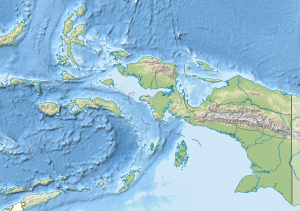Manuk
| Manuk | ||
|---|---|---|
| Satellite image of the island of Manuk (2004) | ||
| Waters | Banda Lake | |
| Archipelago | Moluccas | |
| Geographical location | 5 ° 32 ′ 38 ″ S , 130 ° 18 ′ 19 ″ O | |
|
|
||
| length | 1.36 km | |
| width | 1.02 km | |
| surface | 1 km² | |
| Highest elevation | Gunung Manuk 282 m |
|
| Residents | uninhabited | |
| Manuk in the extreme northeast of the Barat Daya Islands | ||
Manuk (also Manoek ) is a volcanic island in the Moluccas . The uninhabited island in the Banda Sea belongs to the Indonesian province of Maluku .
Manuk has an area of around one square kilometer with a length of approximately 1.4 kilometers and a maximum width of one kilometer. Neighboring islands are Serua (about 90 kilometers south-southwest) and the Banda Islands (about 120 kilometers north-northwest). Manuk is the easternmost island of the Banda Arch . This island arc runs parallel to the subduction zone in which the Australian plate dips under the Eurasian plate .
The island is lined with cliffs and partly surrounded by a coral reef . There is a small sandy beach to the west and forest on the north coast. Manuk is the top one of andesite constructed layer volcano , of 3000 meters rises above the seabed. In the area of the crater that opens to the southeast , Manuk reaches a height of 282 meters above sea level. Fumaroles are active in the crater and on its western edge , which were formerly used by Chinese traders for the extraction of sulfur .
No scientifically proven reports of volcanic eruptions are known from historical times . According to a participant in the Challenger expedition , smoke was said to have risen from the crater in 1874. In the summit area there is a block lava flow that could be less than 100 years old. According to Australian newspaper reports from January and April 1933, a cloud of smoke stood over the island after a volcanic eruption. The observations came from passenger ships that operated between Australia and Hong Kong . The ships headed for Manuk to show the passengers the large number of birds on the island. According to the reports, some of the birds ate the also numerous snakes on the island.
In June 1930 the captain of a passenger ship had provided food to 35 people on Manuk. These came from the island of Ambon , had strayed off course on the way to Serua, had sought refuge on Manuk and for almost a month lived mainly on bird eggs. According to the captain, such occurrences were not unusual.
Web links
Manuk in the Global Volcanism Program of the Smithsonian Institution (English)
Individual evidence
- ^ National Geospatial-Intelligence Agency (ed.): Sailing directions (enroute): New Guinea. Pub. 164, 12th edition, 2011, p. 65 (English, PDF, 3.9 MB).
- ↑ Pieter Zeger Vroon: Subduction of continental material in the Banda Arc, Eastern Indonesia. Sr-Nd-Pb isotope and trace element evidence from volcanics and sediments. (= Geologica Ultraiectina. Volume 90) Utrecht 1992, ISBN 90-71577-44-9 , p. 10 ( online ( page no longer available , search in web archives ) Info: The link was automatically marked as defective. Please check the link accordingly Instructions and then remove this note. , PDF, 9.3 MB).
- ^ Bird Island. A New Volcano. Reported to be Smoking. In: Townsville Daily Bulletin . January 4, 1933, p. 7.
- ^ Volcano Active. In: Cairns Post . April 8, 1933, p. 6.
- ^ "Quite common." Succor of Island Natives. In: The Brisbane Courier . August 9, 1930, p. 20.


